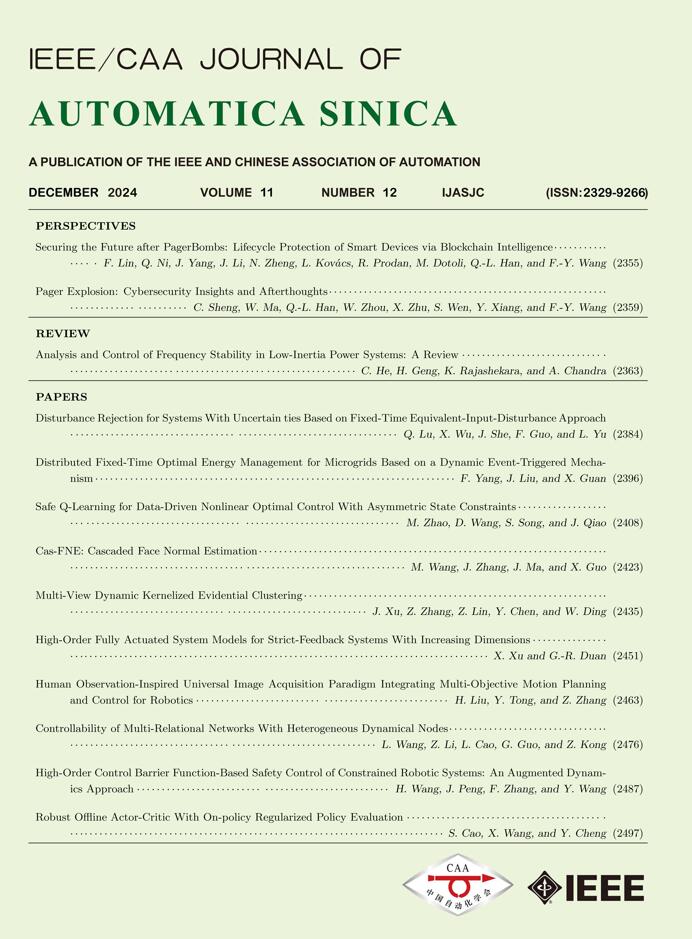 Volume 11
Issue 12
Volume 11
Issue 12
IEEE/CAA Journal of Automatica Sinica
| Citation: | E.-Z. Cao, C. Peng, and Q.-K. Li, “Integrating inventory monitoring and capacity changes in dynamic supply chains with bi-directional cascading propagation effects,” IEEE/CAA J. Autom. Sinica, vol. 11, no. 12, pp. 2515–2518, Dec. 2024. doi: 10.1109/JAS.2023.123309 |

| [1] |
P. Ignaciuk, “Distributed order-up-to inventory control in networked supply systems with delay,” IEEE/CAA J. Autom. Sinica, vol. 8, no. 10, pp. 1709–1714, 2021. doi: 10.1109/JAS.2021.1004147
|
| [2] |
Y. Yang, J. Lin, G. Liu, and L. Zhou, “The behavioural causes of bullwhip effect in supply chains: A systematic literature review,” Int. J. Prod. Econ., vol. 236, p. 108120, 2021.
|
| [3] |
D. Ivanov and A. Dolgui, “OR-methods for coping with the ripple effect in supply chains during COVID-19 pandemic: managerial insights and research implications,” Int. J. Prod. Econ., vol. 232, p. 107921, 2021.
|
| [4] |
D. Ivanov, B. Sokolov, and A. Dolgui, “The Ripple effect in supply chains: Trade-off ‘efficiency-flexibility-resilience’ in disruption management,” Int. J. Prod. Res., vol. 52, no. 7, pp. 2154–2172, 2014. doi: 10.1080/00207543.2013.858836
|
| [5] |
D. Ivanov, S. Sethi, A. Dolgui, and B. Sokolov, “A survey on control theory applications to operational systems, supply chain management, and Industry 4.0,” Annu. Rev. Control, vol. 46, pp. 134–147, 2018. doi: 10.1016/j.arcontrol.2018.10.014
|
| [6] |
P. Ignaciuk, “LQ optimal and robust control of perishable inventory systems with multiple supply options,” IEEE Trans. Automat. Control, vol. 58, no. 8, pp. 2108–2113, 2013. doi: 10.1109/TAC.2013.2246093
|
| [7] |
Q.-K. Li, Y. G. Li, and H. Lin, “H∞ control of two-time-scale Markovian switching production-inventory systems,” IEEE Trans. Control Syst. Technol., vol. 26, no. 3, pp. 1065–1073, 2018. doi: 10.1109/TCST.2017.2692748
|
| [8] |
S. Zhang, X. Li, and C. Zhang, “A fuzzy control model for restraint of bullwhip effect in uncertain closed-loop supply chain with hybrid recycling channels,” IEEE Trans. Fuzzy Syst., vol. 25, no. 2, pp. 475–482, 2017. doi: 10.1109/TFUZZ.2016.2574910
|
| [9] |
D. Fu, H.-T. Zhang, Y. Yu, C.-M. Lonescu, and E.-H. Aghezzaf, “A distributed model predictive control strategy for the bullwhip reducing inventory management policy,” IEEE Trans. Industr. Inform., vol. 15, no. 2, pp. 932–941, 2019. doi: 10.1109/TII.2018.2826066
|
| [10] |
X. Xu, S.-D Lee, H.-S. Kim, and S.-S. You, “Management and optimisation of chaotic supply chain system using adaptive sliding mode control algorithm,” Int. J. Prod. Res., vol. 59, no. 9, pp. 2571–2587, 2021. doi: 10.1080/00207543.2020.1735662
|
| [11] |
C. Li and S. Liu, “A robust optimization approach to reduce the bullwhip effect of supply chains with vendor order placement lead time delays in an uncertain environment,” Appl. Math. Model., vol. 37, no. 3, pp. 707–718, 2013. doi: 10.1016/j.apm.2012.02.033
|
| [12] |
S. Hosseini, D. Ivanov, and A. Dolgui, “Ripple effect modelling of supplier disruption: Integrated Markov chain and dynamic Bayesian network approach,” Int. J. Prod. Res., vol. 58, no. 11, pp. 3284–3303, 2020. doi: 10.1080/00207543.2019.1661538
|
| [13] |
A. Dolgui, D. Ivanov, and M. Rozhkov, “Does the ripple effect influence the bullwhip effect? An integrated analysis of structural and operational dynamics in the supply chain,” Int. J. Prod. Res., vol. 58, no. 5, pp. 1285–1301, 2020. doi: 10.1080/00207543.2019.1627438
|
| [14] |
X. Qiu, L. Yu, and D. Zhang, “Stabilization of supply networks with transportation delay and switching topology,” Neurocomput., vol. 155, pp. 247–252, 2015. doi: 10.1016/j.neucom.2014.12.024
|